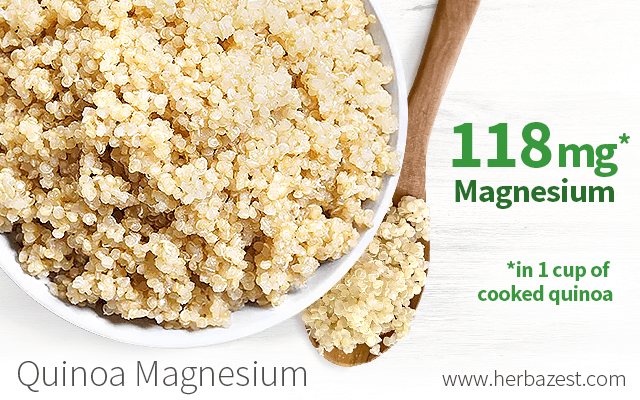Quinoa is a pseudo-grain best known for being a great source of complete protein. However, it is also packed with vitamins and minerals. The high content of magnesium in quinoa may give you another good reason to add this Andean grain to your diet.
What Is Magnesium?
Magnesium is a very important mineral that regulates many biochemical reactions in the body, such as protein synthesis, as well as muscle and nerve function. Magnesium also plays a crucial role in energy production, structural development, and maintaining a normal heart rhythm. Most magnesium stored by the body is present in cells and bones.
It is recommended that adult men between the ages of 19 and 51 consume 400-420 milligrams of magnesium daily, while women of the same age are recommended to consume 350-360 milligrams daily.1 In the United States, surveys have shown that most people consume less than the recommended amounts of magnesium daily.
Some signs of early magnesium deficiency include nausea, vomiting, loss of appetite, and fatigue. As the condition worsens, symptoms may include tingling, abnormal heartbeat, cramps, and even seizures. While symptomatic magnesium deficiency is uncommon in healthy adults, those at greater risk of experiencing magnesium deficiency are people with gastrointestinal diseases, such as Crohn's disease or celiac disease.
Magnesium in Quinoa
Quinoa's magnesium content is very high in comparison to other grains. In fact, a cup of cooked quinoa (185 grams) contains approximately 118 milligrams of magnesium, overthrowing uncooked rye, which contains approximately 110 milligrams of magnesium per 100 grams.2 However, it should be noted that magnesium is heat sensitive and will degrade during the cooking process.
Having a higher magnesium content than many grains, quinoa offers numerous benefits, especially to people who experience magnesium deficiency due to health conditions, such as celiac disease.
QUINOA IS AN EXCELLENT GLUTEN-FREE SOURCE OF MAGNESIUM, SERVING AS AN ALTERNATIVE TO MANY GRAINS.
Quinoa's magnesium content may also be important for people with high blood pressure or those who suffer from migraine headaches since this mineral has been shown to relax blood vessels, thus reducing hypertension.
It is important to note that, compared to quinoa, other foods boast higher levels of magnesium. Some of the best options include dark chocolate, dark green leafy vegetables, and fish.
While quinoa's magnesium content alone will not fulfill your daily recommended dietary requirements of this mineral, it is an excellent complementary source that offers many advantages, especially for people at a higher risk of magnesium deficiency.
Sources
- Journal of Nutrition and Food Sciences, Quinoa (Chenopodium quinoa Willd), from Nutritional Value to Potential Health Benefits: An Integrative Review, 2016
- National Institutes of Health, Magnesium
- Quinoa: High Protein, Gluten-Free, pp. 17-25
- The Blood Pressure Miracle, pp. 31-32
- FAOSTAT, International Year of Quinoa 2013, Nutritional Value
- USDA Nutrient Database, Quinoa, uncooked | Quinoa, cooked | Rye grain | Fish, salmon, Atlantic, wild, raw | Chocolate, dark, 70-85% cacao solids | Spinach, raw
Footnotes:
- Harvard T.H. Chan. (n.d.). Magnesium. Retrieved May 12, 2022 from https://www.hsph.harvard.edu/nutritionsource/magnesium/
- U.S. Department of Agriculture. (2019). Quinoa, cooked. Retrieved May 12, 2022 from https://fdc.nal.usda.gov/fdc-app.html#/food-details/168917/nutrients




